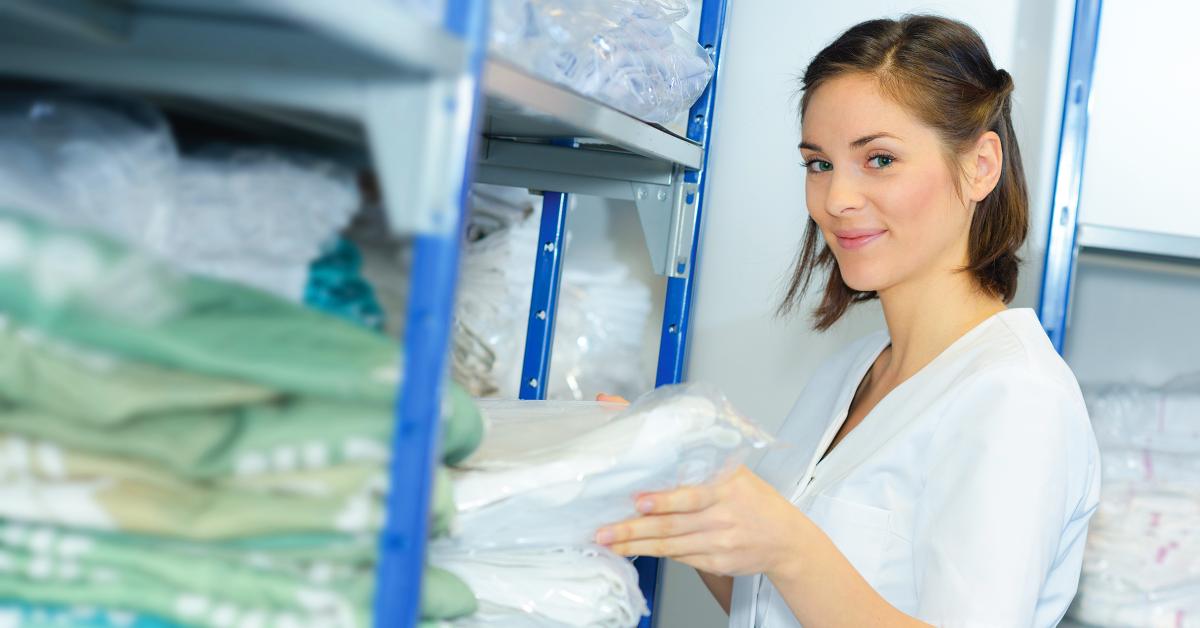CHICAGO — Laundry and linen service has always been about providing customers with clean linens.
But the past few years have put a spotlight on ensuring goods stay clean and hygienic.
That means keeping linens clean from the plant to the delivery trucks to the customer.
American Laundry News reached out to the Association for Linen Management (ALM) and TRSA, the association for linen, uniform and facility services, to learn more about how linen transport has changed and how operations can better ensure goods stay clean throughout the facility and through the transportation cycle.
First, Mitchell Trom, route supervisor for Textile Care Services (part of the Healthcare Linen Services Group) in Rochester, Minnesota, and Sarah Brobek, the new executive director of ALM, and former E.D. Linda Fairbanks, answer questions about transporting hygienic linens.
How has the pandemic influenced how the industry thinks about transporting hygienically clean linens in-plant and to customers?
TROM: There’s a lot more emphasis on PPE (personal protective equipment) and additional disinfectants for people and equipment. Plus, more diligence in maintaining existing hygiene standards.
For example, drivers have always worn gloves. Before the pandemic, they weren’t as conscious about changing those frequently. Once the pandemic hit, everyone started thinking more about protection, and that’s here to stay.
BROBECK and FAIRBANKS: Mostly increased awareness. There have been recent concerns about transport that increase awareness for addressing potential problems such as where are clean textiles delivered at the hospital (is it off-loaded in an area for clean receiving?), how long are the textiles left on the dock, and are they in an appropriate environment at the hospital?
We’ve always received questions, primarily from hospitals, about the “correct way” to protect linen during delivery.
The greatest misunderstanding from the hospital is that there is only one correct way. We talk them through their concerns, help them to understand the various ways to protect the textiles and utilize guidance from the CDC (Centers for Disease Control and Prevention) that addresses their concerns.
Sometimes it takes referring them to their laundry contract for validation. Everyone just wants what’s best for the patient.
How have customer expectations/demands changed in terms of clean linen transport?
TROM: It’s been a moving target with constantly changing rules from customer to customer.
Some days we can go in the customer’s buildings. Some days we need a mask and gloves or maybe eye protection.
The rules are still changing, and it’s up to our drivers to get to know what their customers want. We just keep adjusting as best we can.
BROBECK and FAIRBANKS: During COVID, of course, there were changes in demand and an intense flu season may continue those concerns.
What changes have resulted from the pandemic in transporting clean goods in a plant (carts, conveyors, bags, etc.)? Has equipment changed in the past few years to help ensure clean linen transportation?
TROM: These areas haven’t changed a lot. We have always had strict standards and guidelines to maintain for our customers—especially our biggest customer, Mayo Clinic.
We’ve worked closely with them and their infection control people for years to ensure everything is up to standard.
We have newer sprayers on our loading docks for inside the trucks, and we spray a little more often than we used to. We’ve always documented that we’ve sprayed the whole inside of the truck, so we already had a pretty high standard
BROBECK and FAIRBANKS: Efficiencies and innovations that improve the ability to protect the integrity of the clean textiles will always be a strong consideration.
We have heard of concerns over the use of plastic film/shrink-wrap from hospitals focusing on green initiatives and expect to see some options on that front.
What changes in delivery transportation of clean goods have taken place? What has changed in terms of the equipment drivers use, from carts to delivery trucks?
TROM: Just minor adjustments, putting more emphasis on wiping down the interior of the cab every day. Using some improved spray disinfectants for the cart wash and truck boxes.
BROBECK and FAIRBANKS: During COVID, many hospitals limited outside contractors from entering the facilities. Soiled linen was left on the docks and hospital personnel came outside to meet the clean linen delivery personnel and shepherded the carts inside.
What has changed regarding employee knowledge and practice/processes, first in laundry facilities?
TROM: Everyone is more aware of good practices for not transferring germs. We use a lot more hand sanitizer and masks when needed.
How about with route drivers?
TROM: The drivers are more aware of the hazards associated with the soiled laundry and how to avoid contamination of themselves and the trucks.
We’re doing more wiping out of the truck at the end of shifts. Historically we’ve instructed all drivers to wipe down the truck at the beginning of the shift, recognizing that when their shift is complete, they’re ready to go home.
How can an operation best train its employees on the handling/transport of hygienically clean textiles?
TROM: That’s an ongoing process that never ends. Once you’ve established a standard you have to be a little creative in trying to find new ways to remind people of good practices, so they don’t become complacent.
It’s very easy to start taking shortcuts to try to get your job done sooner. It’s human nature.
For new drivers, our veteran employees get them going in the right direction, teaching them all the good practices of working around a laundry.
It’s an ongoing process even for drivers who have been here forever. You have to keep reminding them and find new ways to tell them the same thing again and again.
BROBECK and FAIRBANKS: No regulatory change that we are aware of, but a heightened need for education as the best means for ensuring staff is following best practices and current guidelines for handling and transporting clean linens.
Managements’ knowledge of unique and specific regulations for their state is essential here.
What steps can a laundry operation take to evaluate its linen transport process to help ensure the cleanliness of goods?
TROM: Once a standard has been set and everyone understands it, you need to make sure the standards are enforced.
Use periodic spot checks, and ride-alongs, to make sure we’re not cutting corners.
BROBECK and FAIRBANKS: Talk with their customers—maintaining hygienically clean linen for patients is a marathon.
The laundry hands off to the driver, the driver hands off to the linen department, the linen department hands off to clinical services, and clinical services delivers to the patient …. They all play a role, and it takes everyone to be successful—educate and cooperate.
Check back Tuesday for Part 2 with information shared by another laundry operator.
Have a question or comment? E-mail our editor Matt Poe at [email protected].




























































































































































































































































